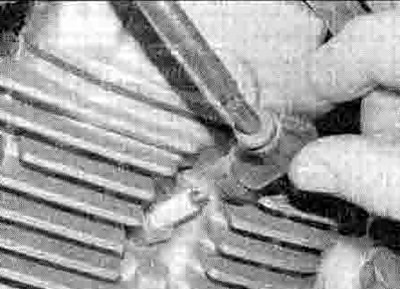Warning: The energy levels In electronic systems can be very high. On no account should the ignition be switched on whilst the plugs or plug caps are being held. Shocks from the HT circuit can be most unpleasant. Secondly, it is vital that the engine is not turned over or run with any of the plug caps removed, and that the plugs are soundly earthed (grounded) when the system is checked for sparking. The ignition system components can be seriously damaged if the HT circuit becomes isolated.
1. As no means of adjustment is available, any failure of the system can be traced to failure of a system component or a simple wiring fault. Of the two possibilities, the latter is by far the most likely. In the event of failure, check the system in a logical fashion, as described below.
A simple spark gap testing tool can be made from a block of wood, a large alligator clip and two nails, one of which is fashioned so that a spark plug cap or bare HT lead end can be connected to its end. Make sure the gap between the two nail ends is the same as specified.
2. Working on one HT lead at a time, disconnect the lead from its spark plug - to access them refer to Chapter 1, Section 5 (see illustration). Connect the lead to a spare spark plug that is known to be good and lay the plug against the cylinder head with the threads contacting it. If necessary, hold the spark plug with an insulated tool.

2.2. Pull the cap off the spark plug
Warning: Do not remove any of the spark plugs from the engine to perform this check - atomised fuel being pumped out of the open spark plug hole could ignite, causing severe injury! Make sure the plugs are securely held against the engine - if they are not earthed when the engine is turned over, the ignition control unit could be damaged.
3. Having observed the above precautions, check that the kill switch is in the RUN position and the transmission is in neutral, then turn the ignition switch ON and turn the engine over on the starter motor. If the system is in good condition a regular, fat blue spark should be evident at the plug electrode. If the spark appears thin or yellowish, or is non-existent, further investigation will be necessary. Turn the ignition OFF and repeal the check for each lead.
4. The ignition system must be able to produce a spark which Is capable of jumping a particular size gap. Honda do not provide a specification, but a healthy system should produce a spark capable of jumping at least 6 mm A simple testing tool can be made to test the minimum gap across which the spark will jump (see Tool Tip). Alternatively spark testing tools are available, some of which are adjustable to set the spark gap distance.
5. Connect one of the spark plug HT leads from one coil to the protruding electrode on the test tool, and clip the tool to a good earth (ground) on the engine or frame. Check that the kill switch is in the RUN position, turn the ignition switch ON and turn the engine over on the starter motor. If the system Is in good condition a regular, fat blue spark should be seen to jump the gap between the nail ends, Repeat the test for the other lead(s) and coil. If the test results are good the entire ignition system can be considered good. If the spark appears thin or yellowish, or is non-existent, further investigation will be necessary.
6. Ignition faults can be divided into two categories, namely those where the ignition system has failed completely, and those which are due to a partial failure. The likely faults are listed below, starting with the most probable source of failure. Work through the list systematically, referring to the subsequent sections for full details of the necessary checks and tests.
Note: Before checking the following items ensure that the battery is fully charged and that all fuses are in good condition.
Loose, corroded or damaged winng connections, broken or shorted wiring between any of the component parts of the ignition system (see Chapter 9).
- Faulty HT lead or spark plug cap. faulty spark plug, dirty, worn or corroded plug electrodes, or incorrect gap between electrodes.
- Faulty ignition (main) switch or engine kill switch (see Chapter 9).
- Faulty neutral, clutch or sidestand switch (see Chapter 9)
- Faulty pulse generator coil or damaged trigger on timing or alternator rotor (according to model),
- Faulty ignition HT coil(s).
- Faulty throttle position sensor (if fitted).
- Faulty ignition control unit.
7. If the above checks don't reveal the cause of the problem, have the ignition system tested by a Honda dealer.
